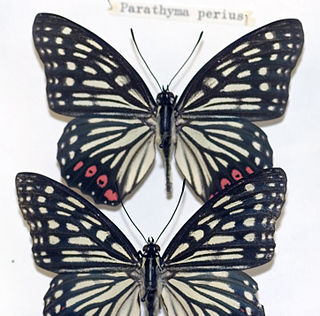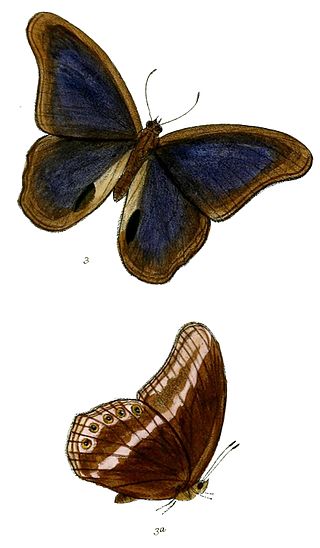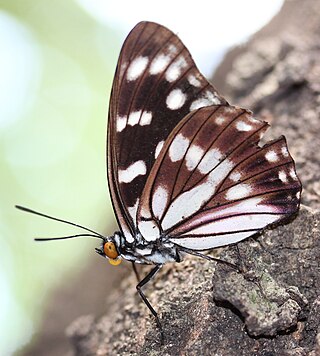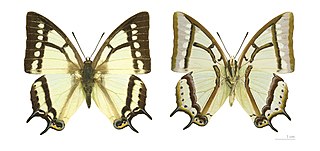
Celtis is a genus of about 60–70 species of deciduous trees, commonly known as hackberries or nettle trees, in the hemp family Cannabaceae. It has a cosmopolitan distribution.

Trema is a genus of about 15 species of evergreen trees closely related to the hackberries (Celtis), occurring in subtropical and tropical regions of southern Asia, northern Australasia, Africa, South and Central America, and parts of North America. They are generally small trees, reaching 10–20 m (33–66 ft) tall.

Libythea is a widespread genus of nymphalid butterflies commonly called beaks or snouts. They are strong fliers and may even be migratory.

Rohana parisatis, the black prince, is a species of butterfly of the family Nymphalidae found in Indomalayan realm.

Hestina assimilis, the red ring skirt, is a species of butterfly in the family Nymphalidae found in Asia. It is generally of large size. There are several subspecies: H. a. assimilis, H. a. formosana (Moore, H. a. shirakii, and H. a. f. nigrivena

Hestina nama, the Circe, is a species of nymphalid butterfly found in South Asia.

Sasakia charonda, the Japanese emperor or great purple emperor, is a species of butterfly in the family Nymphalidae. It is native to Japan, the Korean Peninsula, China, northern Taiwan and northern Vietnam. Its wingspan averages 50 mm (2.0 in) for males, and 65 mm (2.6 in) for females. They are common in the upper canopies of forests, only coming down to feed or to find salt sources. The larvae of the species feed on hackberries, like Celtis jessoensis, Celtis japonica and Celtis sinensis.

Cannabaceae is a small family of flowering plants, known as the hemp family. As now circumscribed, the family includes about 170 species grouped in about 11 genera, including Cannabis (hemp), Humulus (hops) and Celtis (hackberries). Celtis is by far the largest genus, containing about 100 species.

Trema orientale is a species of flowering tree in the hemp family, Cannabaceae. It is known by many common names, including charcoal-tree, Indian charcoal-tree, pigeon wood, Oriental trema, and in Hawaii, where it has become naturalized, gunpowder tree, or nalita. It has a near universal distribution in tropical and warm temperate parts of the Old World, with a range extending from South Africa, through the Middle East, the Indian subcontinent and southern China to Southeast Asia and Australia.

Trema lamarckianum, Lamarck's trema, West Indian nettle tree, or pain-in-the-back is a plant species in the genus Trema of the family Cannabaceae. It is a small evergreen shrub that is native of Florida and the West Indies. It has several common names such as pain-in-back, cabrilla and Lamarck trema. It is 6 m tall growing all year.

Epicopeia is a genus of moths in the family Epicopeiidae. The species in this genus mimic butterflies of the agehana-group in the genus Papilio and Atrophaneura alcinous.

Coelites is a Southeast Asia genus of butterfly in the family Nymphalidae (Satyrinae)

Hestina persimilis, the siren, is an East Palearctic species of siren butterfly (Apaturinae) found in western China, Simla to Assam, Orissa. The larva feeds on Celtis australis.

Hestina japonica is an East Palearctic species of siren butterfly found in Japan and Korea.

Polyura narcaeus, the China nawab, is a butterfly in the family Nymphalidae. It was described by William Chapman Hewitson in 1854. It is found in the Palearctic and Indomalayan realms.
Selepa celtis, called the hairy caterpillar as a larva, is a moth of the family Nolidae. The species was first described by Frederic Moore in 1858. It is found in Oriental tropics of India, Sri Lanka, Taiwan towards the Ryukyu Islands and Australia.
This page is based on this
Wikipedia article Text is available under the
CC BY-SA 4.0 license; additional terms may apply.
Images, videos and audio are available under their respective licenses.















